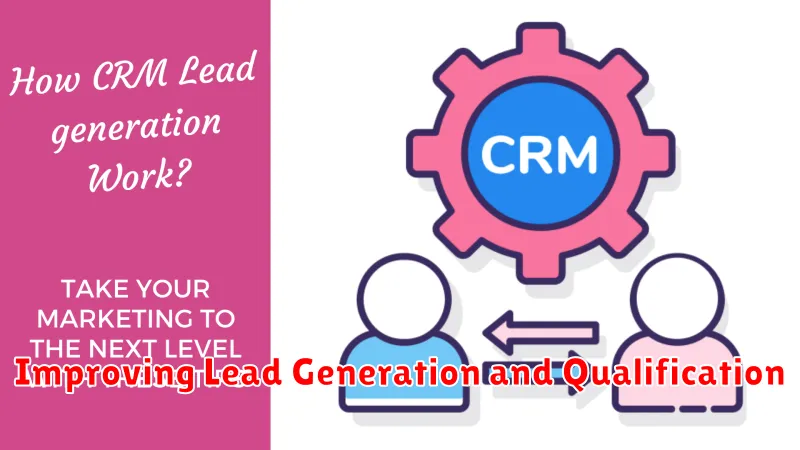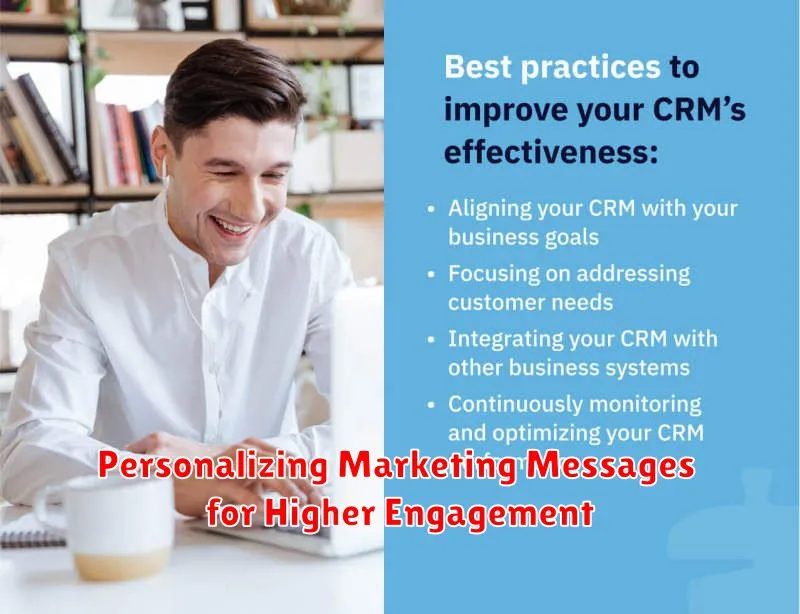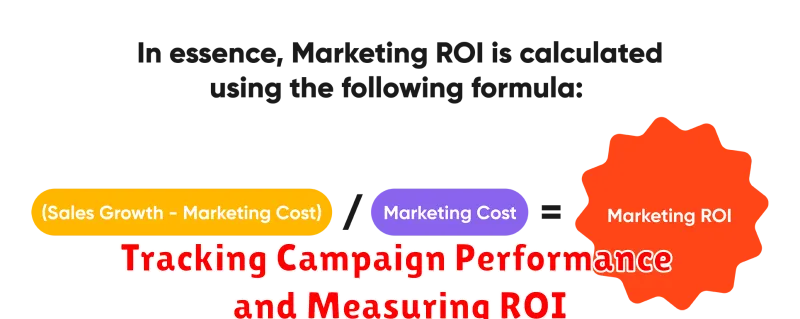Are you looking for ways to boost your marketing ROI and take your business to the next level? Look no further than CRM software! CRM software can help you manage customer interactions, track your marketing campaigns, and ultimately, increase your return on investment. In this blog post, we’ll explore how CRM software can transform your marketing efforts, resulting in more leads, sales, and a loyal customer base.
Understanding the Role of CRM in Marketing
In today’s digital age, businesses are constantly seeking innovative ways to connect with their customers. One of the most effective strategies for building strong customer relationships is through Customer Relationship Management (CRM). A CRM system is a powerful tool that helps businesses manage and organize all their interactions with customers, from initial contact to ongoing engagement. While CRM is often associated with sales, it plays a crucial role in marketing as well.
How CRM Empowers Marketing Efforts
CRM provides a comprehensive view of your customers, allowing you to segment them based on demographics, purchase history, and other relevant data. This enables you to create targeted marketing campaigns that resonate with specific customer groups. For example, you can send personalized email newsletters to customers who have recently purchased a product or tailor your social media ads to the interests of particular segments. By understanding your audience better, you can craft more relevant and impactful marketing messages.
CRM also facilitates customer journey mapping, allowing you to visualize the steps customers take throughout their interaction with your brand. This helps you identify areas for improvement and optimize your marketing efforts at each stage of the customer lifecycle. For example, you can identify bottlenecks in the sales funnel or develop targeted nurture campaigns to encourage leads to convert.
Benefits of Integrating CRM into Your Marketing Strategy
Integrating CRM into your marketing strategy brings numerous benefits, including:
- Improved Customer Segmentation: CRM enables you to segment your audience based on various criteria, allowing for more targeted and effective marketing campaigns.
- Personalized Customer Experiences: With detailed customer data, you can personalize marketing messages, offers, and experiences, leading to greater engagement and loyalty.
- Enhanced Lead Generation: CRM tools can track lead sources, analyze campaign effectiveness, and optimize lead nurturing strategies, resulting in more qualified leads.
- Increased Customer Retention: By providing personalized experiences and addressing customer concerns, you can build stronger relationships and reduce churn rates.
- Data-Driven Insights: CRM data provides valuable insights into customer behavior, preferences, and trends, enabling data-driven decision-making.
Conclusion
CRM is an indispensable tool for modern marketers seeking to build lasting relationships with customers. By leveraging the power of CRM, businesses can gain a deeper understanding of their audience, personalize marketing efforts, and ultimately achieve greater success in today’s competitive marketplace.
How CRM Data Enhances Marketing Campaigns
In the dynamic world of marketing, data reigns supreme. Customer Relationship Management (CRM) systems have become indispensable tools for businesses seeking to understand their customers better and tailor marketing efforts effectively. CRM data provides a wealth of insights that can elevate marketing campaigns, leading to improved engagement, higher conversion rates, and stronger customer relationships.
Personalization Power
One of the most significant benefits of CRM data is the ability to personalize marketing messages. By leveraging customer data like demographics, purchase history, website interactions, and preferences, businesses can create targeted campaigns that resonate with individual customers. This personalization enhances the customer experience, making them feel valued and understood.
Segmentation Strategy
CRM data empowers businesses to segment their customer base into distinct groups based on shared characteristics. This segmentation allows for tailored marketing messages and offers, ensuring that the right message reaches the right audience. For example, segmenting customers by purchase frequency enables businesses to send targeted promotions to encourage repeat purchases.
Predictive Insights
CRM data provides valuable insights into customer behavior and allows for predictive analysis. By identifying patterns and trends, businesses can anticipate customer needs and tailor their marketing strategies accordingly. This proactive approach enables businesses to stay ahead of the curve and offer relevant products or services at the right time.
Campaign Optimization
CRM data plays a vital role in optimizing marketing campaign performance. By tracking key metrics like open rates, click-through rates, and conversion rates, businesses can identify what works and what doesn’t. This data-driven approach allows for continuous improvement and adjustments to ensure that campaigns are delivering the desired results.
Improved Customer Relationships
Ultimately, CRM data helps build stronger customer relationships. By understanding customer preferences and needs, businesses can provide personalized experiences, foster loyalty, and create a more positive customer journey. This enhanced relationship leads to increased customer satisfaction, repeat business, and positive word-of-mouth referrals.
Conclusion
CRM data is a powerful resource that can significantly enhance marketing campaigns. By leveraging its insights, businesses can personalize messages, segment audiences, optimize campaigns, and build stronger customer relationships. In today’s competitive market, harnessing the power of CRM data is essential for businesses to achieve success.
Improving Lead Generation and Qualification

In today’s competitive business landscape, generating and qualifying leads is crucial for business success. Lead generation is the process of attracting potential customers to your business, while lead qualification involves determining whether those leads are a good fit for your products or services.
Effective lead generation and qualification strategies can significantly improve your sales pipeline, increase conversion rates, and ultimately drive revenue growth. Here are some key strategies to enhance your lead generation and qualification processes:
1. Define Your Ideal Customer Profile (ICP)
Before you start generating leads, it’s essential to define your ideal customer profile (ICP). This involves understanding the characteristics, needs, and pain points of your target audience. By clearly defining your ICP, you can focus your marketing efforts on the most qualified prospects, increasing the chances of converting them into paying customers.
2. Utilize a Multi-Channel Marketing Approach
Don’t rely on a single marketing channel to reach your target audience. Employ a multi-channel marketing approach that includes various strategies such as:
- Content marketing: Create valuable and informative content that attracts your target audience, such as blog posts, ebooks, and webinars.
- Social media marketing: Engage with your audience on relevant social media platforms, sharing valuable content and running targeted advertising campaigns.
- Email marketing: Build an email list and send targeted emails to nurture leads and provide valuable information.
- Search engine optimization (SEO): Optimize your website for relevant keywords to increase visibility in search engine results pages (SERPs).
- Paid advertising: Run targeted advertising campaigns on platforms like Google Ads, Facebook Ads, and LinkedIn Ads.
3. Implement Lead Capture Forms
Make it easy for potential customers to provide their information by using lead capture forms on your website, landing pages, and social media profiles. Keep the forms short and concise, only asking for essential information.
4. Use Lead Scoring Systems
Lead scoring systems help prioritize leads based on their potential value. Assign points to leads based on factors such as demographics, website behavior, and engagement with your content. Leads with higher scores are more likely to be qualified and ready for a sales conversation.
5. Implement a Strong Sales Follow-Up Process
Once you’ve identified qualified leads, it’s important to follow up promptly and effectively. Use a CRM system to track your interactions with leads and ensure timely communication. Provide valuable information, answer their questions, and guide them through the sales process.
6. Continuously Analyze and Optimize
Regularly track and analyze your lead generation and qualification efforts to identify areas for improvement. Monitor key metrics like conversion rates, lead quality, and time to close deals. Use this data to refine your strategies and maximize your return on investment.
7. Leverage Technology
Technology can significantly enhance your lead generation and qualification processes. Use tools such as CRM systems, marketing automation platforms, and lead scoring software to streamline your workflows and gain valuable insights.
By implementing these strategies, you can improve your lead generation and qualification processes, resulting in a stronger sales pipeline, higher conversion rates, and ultimately, greater business success.
Segmenting Your Target Audience with CRM
In today’s competitive market, it is crucial to understand your target audience and tailor your marketing efforts accordingly. Customer Relationship Management (CRM) software can be a powerful tool for achieving this, as it allows you to segment your audience based on various factors such as demographics, purchase history, engagement levels, and more.
Segmenting your target audience has numerous benefits:
- Personalized Communication: By segmenting your audience, you can personalize your communications based on their individual needs and preferences. This results in more relevant and engaging interactions, leading to higher conversion rates and increased customer satisfaction.
- Targeted Marketing Campaigns: CRM systems enable you to target specific segments of your audience with tailored marketing campaigns. This reduces wasted effort and resources by focusing on the most receptive groups.
- Improved Customer Experience: Understanding your audience’s needs and preferences allows you to provide a more personalized and relevant customer experience. This fosters loyalty and strengthens relationships.
- Increased ROI: By focusing your marketing efforts on the right audience, you can achieve higher ROI and maximize your return on investment.
Here are some common ways to segment your target audience using CRM:
- Demographics: Age, gender, location, income, education level
- Purchase History: Previous purchases, purchase frequency, average order value
- Engagement Levels: Website visits, email opens, social media interactions
- Customer Behavior: Browsing history, product preferences, website navigation
Once you have segmented your audience, you can leverage CRM features to create targeted campaigns, automate personalized communications, and track the effectiveness of your efforts. By using CRM for audience segmentation, businesses can gain a deeper understanding of their customers, improve their marketing effectiveness, and drive better results.
Personalizing Marketing Messages for Higher Engagement

In today’s digital landscape, consumers are bombarded with marketing messages from all directions. To cut through the noise and make a lasting impression, brands need to personalize their marketing efforts. Personalization goes beyond simply using a customer’s name; it’s about understanding their unique needs, preferences, and behaviors and tailoring messages accordingly. This article will explore the key strategies for personalizing marketing messages and achieving higher engagement.
The Power of Personalization
Personalized marketing delivers a more relevant and engaging experience for customers. It helps build stronger relationships by demonstrating that you understand their individual needs and preferences. When customers feel valued and understood, they are more likely to:
- Engage with your brand
- Make purchases
- Become loyal customers
- Recommend your brand to others
Key Strategies for Personalization
Here are some key strategies to implement personalized marketing messages:
1. Collect and Analyze Customer Data
The foundation of effective personalization lies in collecting and analyzing relevant customer data. This data can include:
- Demographics: Age, location, gender, income, etc.
- Purchase history: Past purchases, order frequency, average order value
- Website behavior: Pages visited, time spent on site, search terms used
- Email interactions: Open rates, click-through rates, email preferences
- Social media activity: Likes, comments, shares, interests
2. Segment Your Audience
Once you have collected customer data, segment your audience into groups with shared characteristics. This allows you to deliver targeted messages that resonate with each segment. For example, you might segment your audience by:
- Purchase history: First-time buyers vs. repeat customers
- Product interest: Customers interested in specific product categories
- Engagement level: Highly engaged vs. inactive customers
3. Use Dynamic Content
Dynamic content allows you to personalize messages based on real-time data. This can include:
- Personalized product recommendations: Based on past purchases, browsing history, or similar products
- Dynamically generated email subject lines: Using the customer’s name or referencing a specific product they viewed
- Personalized landing pages: Tailored to the customer’s interests and needs
4. Utilize AI and Machine Learning
AI and machine learning can automate the personalization process and deliver even more targeted messages. These technologies can analyze vast amounts of data and identify patterns to predict customer behavior and preferences. This allows you to offer personalized recommendations, predict churn, and optimize marketing campaigns in real-time.
Measuring the Success of Your Personalization Efforts
To ensure that your personalization efforts are effective, it’s crucial to track key metrics. These metrics can include:
- Open rates and click-through rates: For email campaigns
- Website conversion rates: For landing pages and product pages
- Customer lifetime value (CLTV): A measure of the total revenue a customer generates over their relationship with your brand
- Customer satisfaction scores: Feedback surveys to gauge customer sentiment
Conclusion
Personalization is no longer a luxury; it’s a necessity for brands seeking to connect with their audience and achieve higher engagement. By implementing the strategies outlined above, you can create more relevant and engaging experiences that drive customer loyalty and business growth.
Tracking Campaign Performance and Measuring ROI

In today’s competitive market, it’s crucial for businesses to track their campaign performance and measure their return on investment (ROI) to ensure they’re getting the most out of their marketing efforts. By understanding how your campaigns are performing, you can identify what’s working and what’s not, optimize your strategies, and ultimately achieve your business goals.
Key Metrics to Track
There are many metrics you can track to measure campaign performance, but some of the most important include:
- Reach: The number of people who saw your campaign.
- Frequency: The average number of times each person saw your campaign.
- Engagement: The number of people who interacted with your campaign (e.g., clicked on a link, watched a video, etc.).
- Conversions: The number of people who took a desired action (e.g., made a purchase, signed up for a newsletter, etc.).
- Cost per acquisition (CPA): The amount of money you spend to acquire a new customer.
- Return on ad spend (ROAS): The amount of revenue generated for every dollar spent on advertising.
Tools and Platforms for Tracking
There are a variety of tools and platforms available to help you track campaign performance and measure ROI. Some popular options include:
- Google Analytics: A free tool that provides detailed website analytics.
- Google Ads: A platform for creating and managing online advertising campaigns.
- Facebook Ads Manager: A tool for creating and managing Facebook advertising campaigns.
- HubSpot: A marketing automation platform that offers a range of features for tracking campaign performance.
- Mailchimp: An email marketing platform that provides detailed reporting on email campaign performance.
Best Practices for Tracking and Measurement
Here are some best practices for tracking campaign performance and measuring ROI:
- Set clear goals and objectives: Before launching a campaign, define what you hope to achieve. This will help you identify the right metrics to track.
- Use a consistent tracking system: Use the same tracking methods across all your campaigns to ensure consistency and accuracy.
- Track your results regularly: Don’t wait until the end of a campaign to analyze your data. Monitor your performance on a regular basis to identify areas for improvement.
- Experiment and optimize: Don’t be afraid to try different things and see what works best. Use your data to continuously optimize your campaigns.
Conclusion
Tracking campaign performance and measuring ROI is essential for any business that wants to maximize its marketing return. By implementing the best practices outlined above, you can gain valuable insights into your campaigns, improve your strategies, and achieve your business goals.
Integrating CRM with Marketing Automation Tools
In today’s digital age, businesses are constantly looking for ways to improve their marketing efforts and achieve greater success. One powerful combination that can help achieve this goal is integrating CRM (Customer Relationship Management) with marketing automation tools.
CRM software helps businesses manage customer interactions and data, while marketing automation tools streamline repetitive marketing tasks and automate campaigns. When integrated, these two systems create a powerful synergy that can drive significant improvements in lead generation, customer engagement, and overall marketing performance.
Benefits of Integrating CRM with Marketing Automation
- Improved Lead Nurturing: By integrating CRM and marketing automation, businesses can create targeted and personalized nurturing campaigns that deliver the right message at the right time to each individual lead.
- Enhanced Customer Segmentation: With access to comprehensive customer data from the CRM, marketing automation tools can segment audiences more effectively, allowing businesses to send tailored messages to different customer groups.
- Automated Marketing Campaigns: Integrating CRM and marketing automation eliminates the need for manual tasks, such as email blasts and social media updates. This frees up valuable time for marketers to focus on strategic initiatives.
- Increased ROI: By optimizing marketing campaigns and improving customer engagement, businesses can achieve a higher return on their marketing investments.
- Better Sales Alignment: By sharing data and insights between CRM and marketing automation, sales and marketing teams can work more collaboratively, leading to improved lead qualification and conversion rates.
Tips for Successful Integration
To ensure a successful integration of CRM and marketing automation, businesses should consider the following tips:
- Choose Compatible Tools: Select CRM and marketing automation tools that offer seamless integration capabilities.
- Define Clear Goals: Establish specific goals for the integration, such as increasing lead generation or improving customer retention.
- Start with a Pilot Project: Begin with a small-scale pilot project to test the integration and identify any potential challenges.
- Provide Training and Support: Ensure that all relevant stakeholders are properly trained on using the integrated systems.
- Monitor and Optimize: Regularly monitor the performance of the integration and make adjustments as needed to maximize results.
Conclusion
Integrating CRM with marketing automation tools is a powerful strategy for businesses of all sizes. By leveraging the combined power of these systems, companies can streamline marketing operations, improve customer engagement, and achieve greater success in today’s competitive marketplace.
